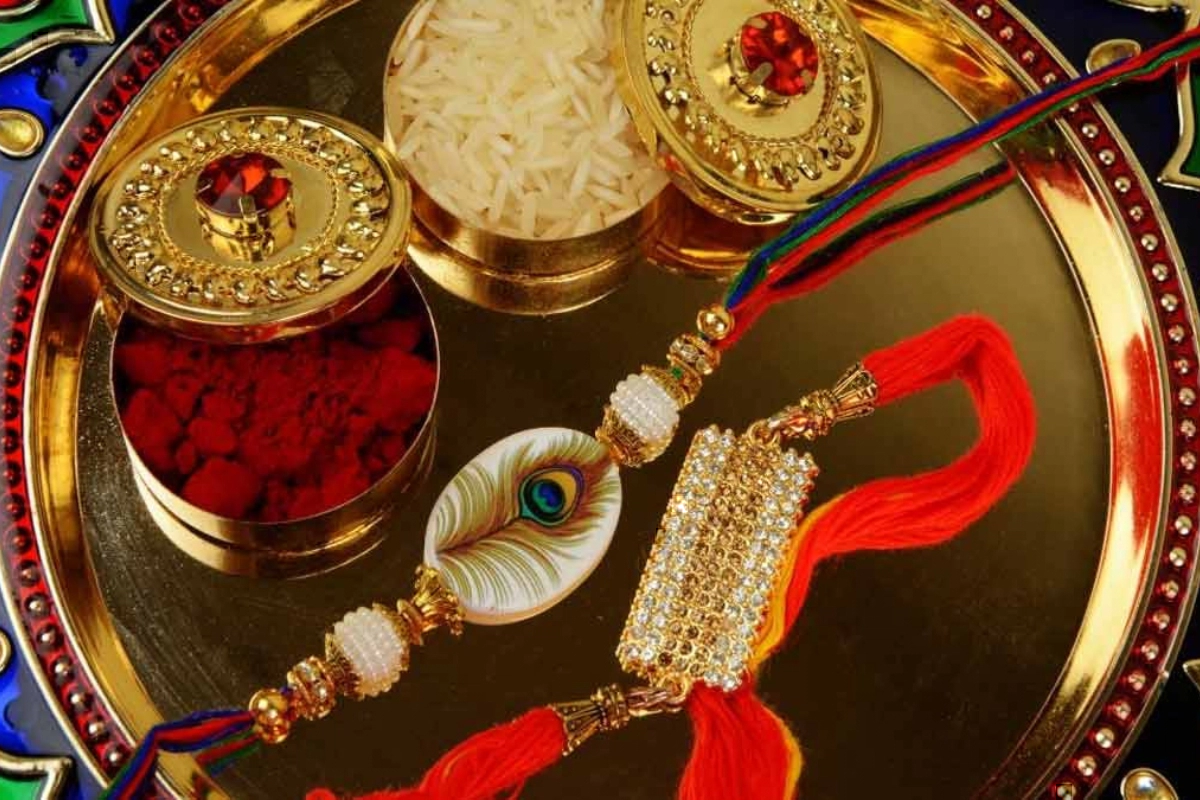Rakhi Celebrations: A Day of Brother or Sister Love and Commitment
Rakhi, also known as Raksha Bandhan, is one of India’s most treasured celebrations, commemorated with tremendous love and enthusiasm. This special day is devoted to the unique bond between siblings, transcending mere biological connections to encompass an emotional commitment of love, protection, and lifelong friendship. Observed on the full moon day of the Hindu month of Shravana, Rakhi is not just a ritualistic custom but a celebration of the timeless bond that siblings share.
The Significance of Raksha Bandhan
The term “Raksha Bandhan” translates to “the bond of protection,” perfectly capturing the event’s core sentiment. The central ritual involves siblings tying a sacred thread, referred to as a “rakhi,” around their brothers’ wrists. This simple act symbolizes the sister’s prayers for her brother’s well-being and prosperity, and in return, the brother’s promise to protect her under any circumstances. The rakhi itself holds significant emotional value, often adorned with intricate designs, beads, and even jewels, representing the sister’s love and best wishes.
Preparations and Traditions
The preparations for Rakhi start well in advance. Sisters eagerly shop for rakhis, selecting ones that best express their love and affection. The market is flooded with various rakhis, from traditional threads to modern, themed designs, catering to all ages and tastes. Some rakhis are crafted with traditional motifs, while others may feature cartoon characters, reflecting the sister’s personal touch and thoughtfulness.
In addition to rakhis, the festival involves exchanging gifts and sweets. Sisters often prepare their brothers’ favorite sweets, such as laddoos, barfis, and other traditional Indian delicacies, adding a personal and nostalgic touch to the celebrations. Brothers, in turn, reciprocate with gifts for their sisters, ranging from jewelry and clothing to gadgets and money. This exchange of presents is more than a mere transaction; it symbolizes mutual respect, love, and the desire to make each other feel special.
The Rituals of Rakhi
On the day of Raksha Bandhan, the atmosphere is filled with excitement and joy. Families come together, often traveling from afar, to participate in the celebration. The ritual begins with the sister performing an aarti, a traditional Hindu ritual of lighting a lamp and revolving it in front of her brother, signifying the warding off of negative energies. She then applies a tilak (a mark) on his forehead, representing blessings and good fortune.
The most awaited moment follows: the sister ties the rakhi around her brother’s wrist, praying for his health and happiness. This act is accompanied by a sweet offering, which the brother accepts as a token of the sister’s love. The brother then gifts his sister, promising to protect and support her throughout life. This ritual not only strengthens the bond between siblings but also rekindles fond memories and reaffirms their commitment to each other.
Modern Interpretations and Innovations
In the contemporary world, Rakhi has evolved in various ways to adapt to changing times and circumstances. With families often living in different parts of the world, the festival has embraced modern technology, allowing siblings to celebrate together virtually. Video calls, e-rakhis, and online gift deliveries have become integral to the celebration, ensuring that distance does not diminish the event’s spirit. Many online platforms offer a wide range of rakhis and gifts, enabling sisters to send their love to their brothers across borders.
Moreover, Rakhi has expanded beyond the traditional brother-sister relationship. It has become a day to honor all forms of sibling-like bonds. Many women tie rakhis on the wrists of their cousins, close friends, and even neighbors, signifying their emotional connection and mutual respect. Some even extend the gesture to non-family members, like soldiers or community workers, as a token of appreciation and solidarity.
Cultural Significance and Stories
Rakhi is deeply rooted in Indian culture and mythology, with numerous stories highlighting the festival’s significance. One of the most famous legends is that of Lord Krishna and Draupadi. According to the Mahabharata, when Krishna injured his finger, Draupadi tore a piece of her saree and tied it around his wound to stop the bleeding. Touched by her gesture, Krishna vowed to protect her, symbolizing the essence of Raksha Bandhan.
Another popular story is that of Rani Karnavati of Chittor and Emperor Humayun. Facing an imminent invasion, Rani Karnavati sent a rakhi to Humayun, seeking his protection. Moved by the gesture, Humayun immediately set out to defend her kingdom. These stories, among others, emphasize the festival’s values of love, duty, and protection.
The Emotional and Social Impact
Rakhi is more than just a celebration; it is an emotional anchor that brings families together, often bridging gaps and resolving conflicts. It is a day when siblings set aside their differences, reminisce about their shared experiences, and renew their vows of love and support. The festival fosters a sense of unity and belonging, reinforcing the importance of familial bonds.
In a broader social context, Rakhi promotes harmony and goodwill. It encourages the spirit of caring and protecting others, transcending religious and cultural boundaries. The festival serves as a reminder of the universal values of love, respect, and compassion, which are the cornerstones of any healthy society.
Conclusion
Rakhi is a beautiful celebration of the bond between siblings, a day filled with rituals, gifts, laughter, and love. It is a festival that transcends time, evolving with changing societal norms while retaining its core values. The sacred thread tied on Raksha Bandhan symbolizes not just the sister’s prayers and the brother’s promise but also the unbreakable bond of love and commitment that defines sibling relationships.
As families gather, whether in person or virtually, to celebrate this special day, they create memories that will last a lifetime. Rakhi is a testament to the enduring nature of sibling love, a bond that withstands the test of time, distance, and life’s many challenges. It is a day to cherish the special connection between siblings, honor their unique relationship, and celebrate the joy of having someone to love and protect, no matter what.
For more information on exploring the vibrant culture and rich traditions of India, consider checking out Rajasthan Tour Packages and experience the magic of this incredible region.
Rakhi Celebrations: A Day of Brother or Sis Love and Dedication
Q1 :Rakhi Celebrations – Fastival date and time 2024 ?
A : Date: In 2024, Rakhi (Raksha Bandhan) will be celebrated on Monday, August 19.
Time: Rakhi rituals typically take place throughout the day. For 2024, the auspicious timing (muhurta) for tying the rakhi is from 10:11 AM to 7:08 PM. It’s important to follow these timings for the rituals, as they are considered the most favorable.
Q2 : What is Rakhi, likewise called Raksha Bandhan?
A: Rakhi, additionally referred to as Raksha Bandhan, is a treasured Indian celebration commemorated to honor the bond between brother or sisters. It transcends plain biological links and symbolizes an emotional commitment of love, security, and lifelong friendship.
Q3 : When is Rakhi commemorated?
A: Rakhi is commemorated on the moon day of the Hindu month of Shravana.
Q4 : What does the term “Raksha Bandhan” mean?
A: The term “Raksha Bandhan” equates to “the bond of defense,” catching the significance of the festival, which is about the dedication of brother or sisters to safeguard and care for each other.
Q5 : What is the central ritual of Raksha Bandhan?
A: The central ritual entails the sister connecting a spiritual string, called a “rakhi,” around her bro’s wrist. This act signifies her petitions for his well-being and success, and in return, the sibling assures to secure her under any kind of circumstances.
Q6 : How do siblings prepare for Rakhi?
A: Siblings shop for rakhis that best reveal their love and love. Markets are filled with numerous rakhis, from conventional styles to contemporary motifs. Sisters often prepare their siblings’ favorite sweets, and brothers reciprocate with presents.
Q7 : What are some typical rituals done on Raksha Bandhan?
A: The routines consist of the sister performing an aarti, applying a tilak on the bro’s forehead, connecting the rakhi, and offering sugary foods. The bro then presents the sister, declaring his dedication to secure and sustain her.
Q8 : Just how has the party of Rakhi developed in contemporary times?
A: With households often living apart, Rakhi has embraced innovation, allowing siblings to commemorate essentially via video phone calls, e-rakhis, and on-line present shipments. The event has actually likewise prolonged past traditional brother-sister relationships to honor all sibling-like bonds.
Q9 : What are some well-known stories related to Rakhi?
A: Noteworthy tales include the bond between Lord Krishna and Draupadi, where Krishna guaranteed to secure Draupadi after she linked a piece of her saree around his damaged finger, and the tale of Rani Karnavati and Emperor Humayun, where Humayun replied to her call for defense by defending her kingdom.
Q10 : What is the emotional and social effect of Rakhi?
A: Rakhi works as an emotional support, bringing households with each other, resolving conflicts, and enhancing bonds. It promotes consistency, a good reputation, and the universal values of love, regard, and compassion.
Q11 : What does the sacred string tied on Raksha Bandhan represent?
A: The spiritual thread represents the sis’s prayers and the brother’s pledge of security. It represents the unbreakable bond of love and dedication that defines sibling partnerships.
Q12 : Just how is Rakhi celebrated in various parts of the globe?
A: While the core routines stay the exact same, Rakhi is commemorated with special local customs and customs throughout India and by Indian communities worldwide. The celebration’s significance remains an event of sibling love and security.
Q13 : What can one do if they can not be literally present with their brother or sister on Rakhi?
A: Siblings can celebrate Rakhi virtually with video clip phone calls, send out e-rakhis, or order presents online. These contemporary adjustments guarantee that range does not minimize the event’s spirit.
Q14 : What is the significance of gifts in the Rakhi celebration?
A: The exchange of presents represents the shared regard and love between siblings. It is a gesture to make each other feeling special and cherished.
Q15 : What are some typical presents traded during Rakhi?
A: Presents can vary from sweets, precious jewelry, clothes, gadgets, and money. The choice of gift usually reflects the personal choices and affection of the siblings.
Q16 : Exactly how does Rakhi promote social consistency?
A: By encouraging the spirit of caring and protecting others, Rakhi transcends religious and social limits, cultivating a sense of unity and a good reputation in society.
Q17 : What does Rakhi instruct us concerning sibling partnerships?
A: Rakhi teaches us that sibling partnerships are built on love, depend on, and a lifelong dedication to support and protect each other, despite life’s challenges.












